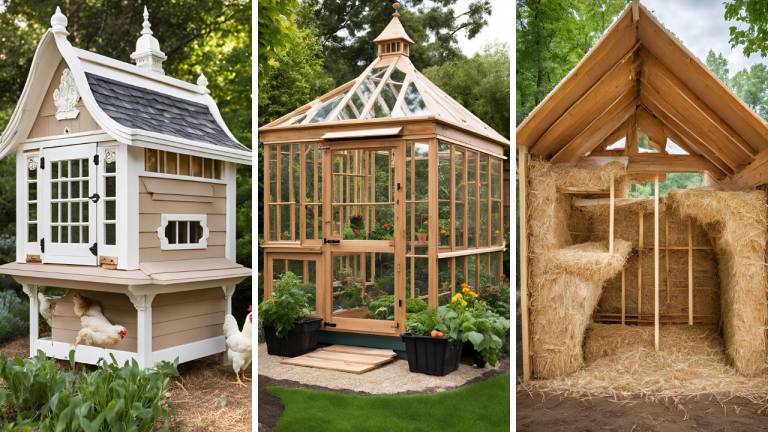Creating an inviting, well-defined walkway doesn’t have to break the bank. Whether you’re looking to enhance your garden, patio, or backyard, a DIY walkway is an excellent way to improve the flow of your outdoor space. In this two-part guide, we’ll explore 23 cheap walkway ideas that can elevate your yard, all while keeping costs low. In this first part, we’ll cover the first 12 ideas, ranging from simple gravel paths to creative DIY designs using recycled materials. Let’s dive in and discover how you can design a beautiful, budget-friendly walkway for your outdoor haven!
1. Gravel Walkway: Classic and Budget-Friendly
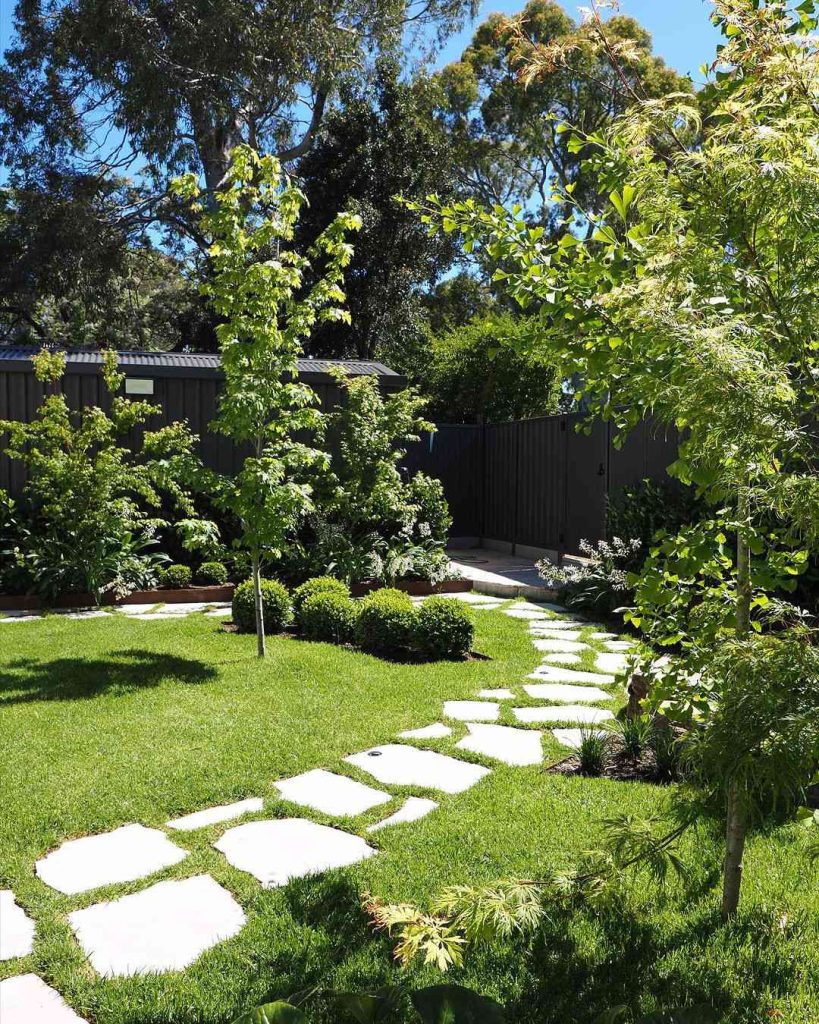
Gravel is a timeless, affordable choice for creating a pathway. Not only is it incredibly easy to install, but it also provides a natural, rustic appearance that complements various landscaping styles. The key to creating a gravel walkway is choosing the right materials and ensuring proper drainage.
To begin, you’ll need to measure and mark the area where you want the path to go. Dig about 2-3 inches deep to create a foundation for the gravel. Lay down a weed barrier fabric to prevent unwanted plants from growing through the gravel. Then, pour your gravel and level it out to create a smooth, even surface. For added stability, you can use larger rocks along the edges to keep the gravel in place.
For a personalized touch, consider mixing different colors and textures of gravel to create a more unique, visually appealing path. Gravel paths are not only low-cost, but they’re also easy to maintain – simply replenish the gravel as needed.
2. Brick Pathway: Timeless Elegance on a Budget
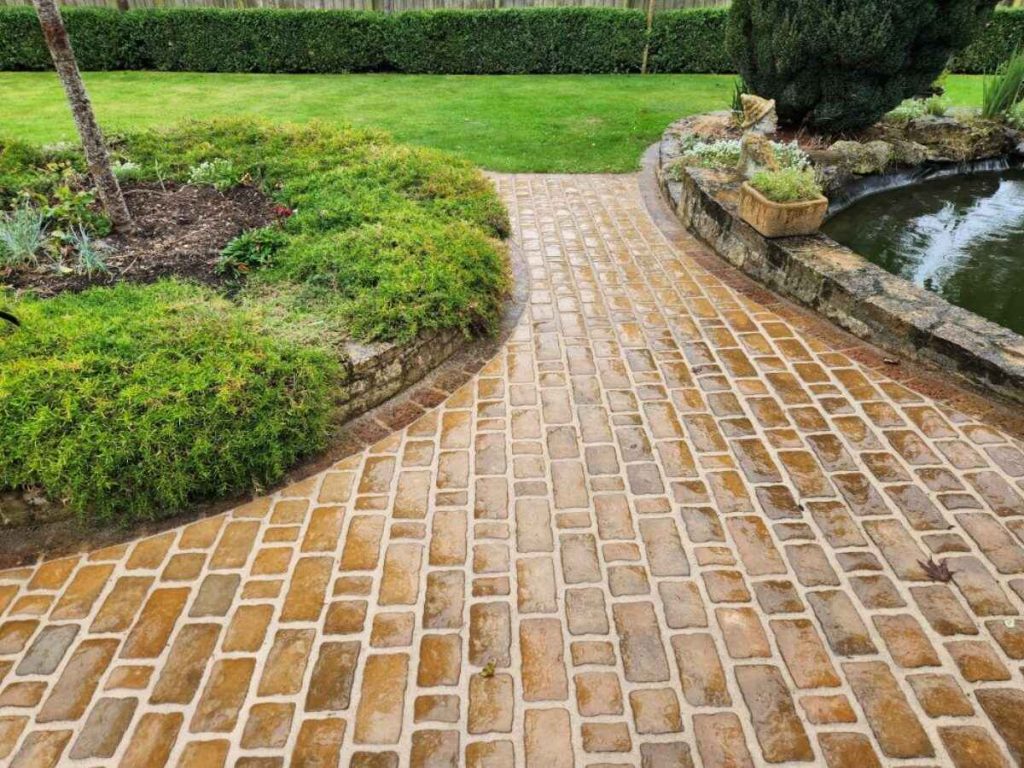
Brick pathways have a classic, elegant look that complements any garden style. Whether you’re designing a formal walkway or a more relaxed, casual path, bricks provide versatility and charm. The beauty of a brick walkway is that you can use reclaimed bricks to save even more money.
To install a brick pathway, start by laying down a layer of sand or crushed stone to provide a stable foundation. Then, arrange your bricks in a pattern of your choice – herringbone, running bond, or a simple grid layout. You can set the bricks tightly together or leave small gaps for added texture. Once your bricks are laid out, fill in the gaps with sand to hold them in place.
For a more rustic feel, you can allow moss or ground cover plants to grow between the bricks, adding a touch of nature to the pathway.
3. Concrete Pavers: Affordable and Sleek
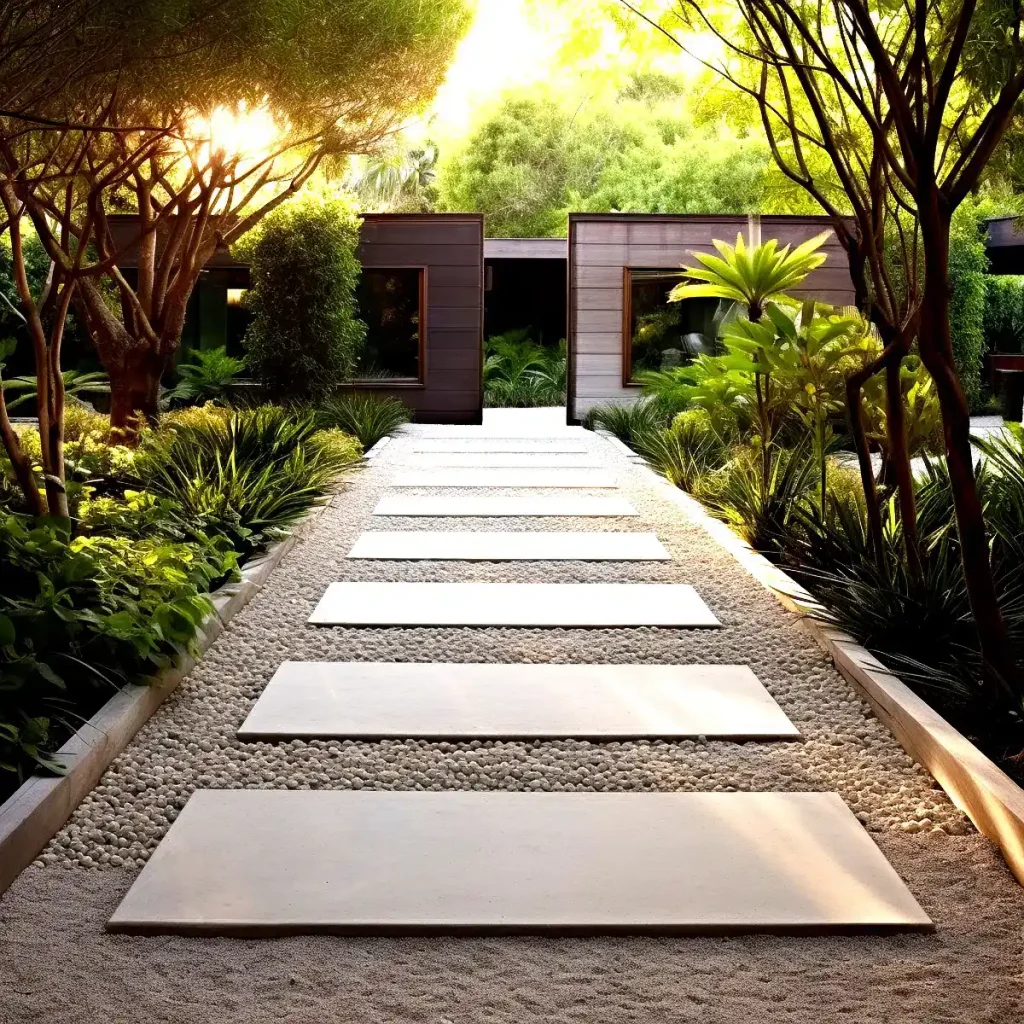
Concrete pavers are an affordable alternative to stone walkways, offering the same sleek, modern look at a fraction of the cost. These pavers are available in a wide range of sizes, shapes, and colors, allowing you to customize the walkway to fit your unique style.
To create a concrete paver walkway, start by clearing the area and laying down a weed barrier. Then, level the ground and lay your pavers in the desired pattern. You can place them close together for a more seamless look or leave small gaps to add a bit of texture. Once the pavers are in place, fill in the gaps with sand to keep them secure.
Concrete pavers are incredibly durable and can withstand the elements, making them an excellent long-term investment for your outdoor space.
4. Stepping Stones with Moss: A Natural Look
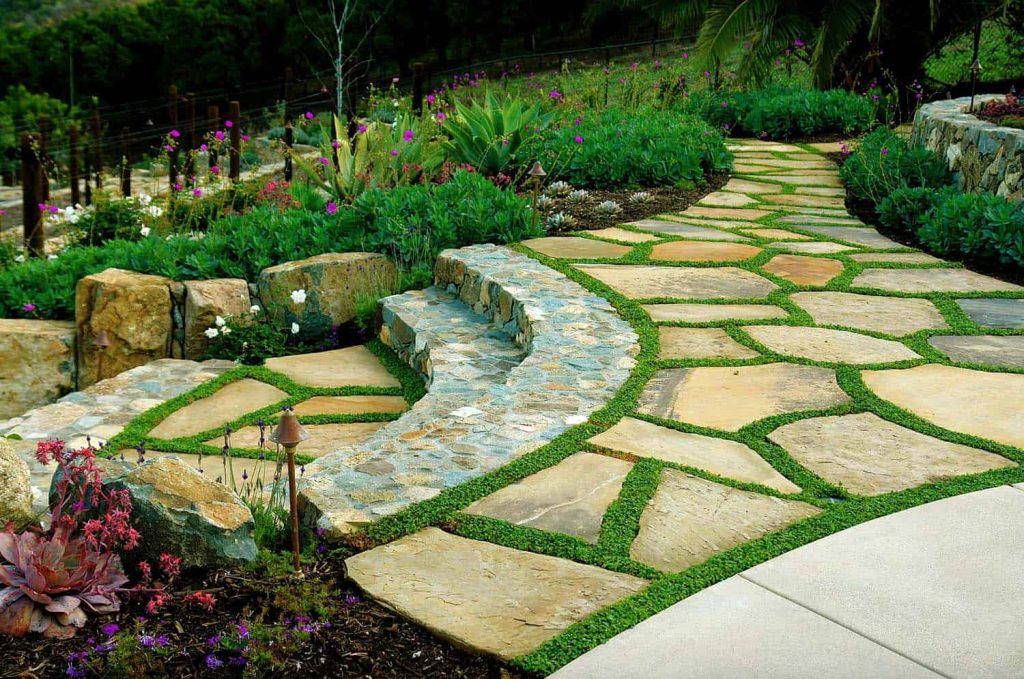
Stepping stones with moss provide a charming, natural appearance that blends perfectly with garden settings. This pathway option gives you the opportunity to incorporate your love for nature into your outdoor space. It’s also a fantastic option for those who want a simple DIY project that doesn’t require a lot of heavy lifting.
To create this type of walkway, start by laying large, flat stepping stones in the desired pattern. Ensure they’re spaced evenly and leave gaps between them to allow room for the moss to grow. Next, cover the spaces with a mixture of moss, soil, and water, pressing it down gently. Over time, the moss will naturally spread and fill in the gaps, creating a lush, green walkway.
The best part about stepping stones with moss is that it’s low maintenance, as moss requires very little attention once it’s established.
5. Wood Slice Walkway: Rustic Charm
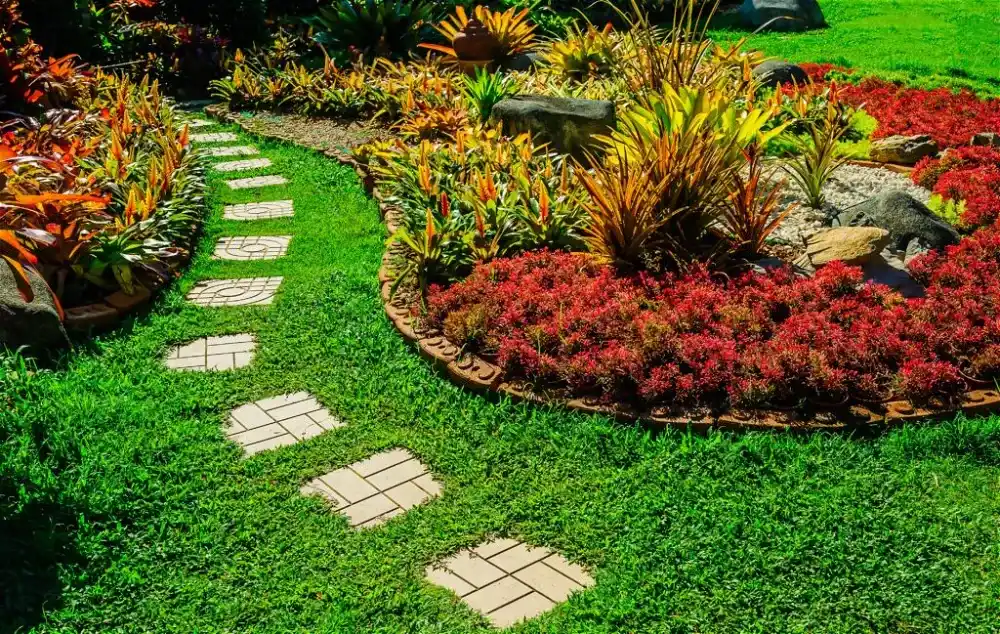
A wood slice walkway adds a rustic, earthy touch to your outdoor space. This type of path is perfect for nature lovers or anyone wanting a more organic feel. You can create this walkway using fallen tree branches or reclaimed wood slices, making it an eco-friendly option as well.
Start by collecting wood slices, and ensure they’re all roughly the same size. Lay them out in a pattern, either in a straight line or a more meandering design, depending on your preference. If you prefer a more secure surface, you can glue or nail the slices to a wooden board for added stability. For durability, you can treat the wood with a sealant or wood preservative to help protect it from the elements.
A wood slice walkway is not only budget-friendly but also offers a natural, rustic charm that will elevate any garden.
6. Repurposed Tile Path: Creative and Colorful
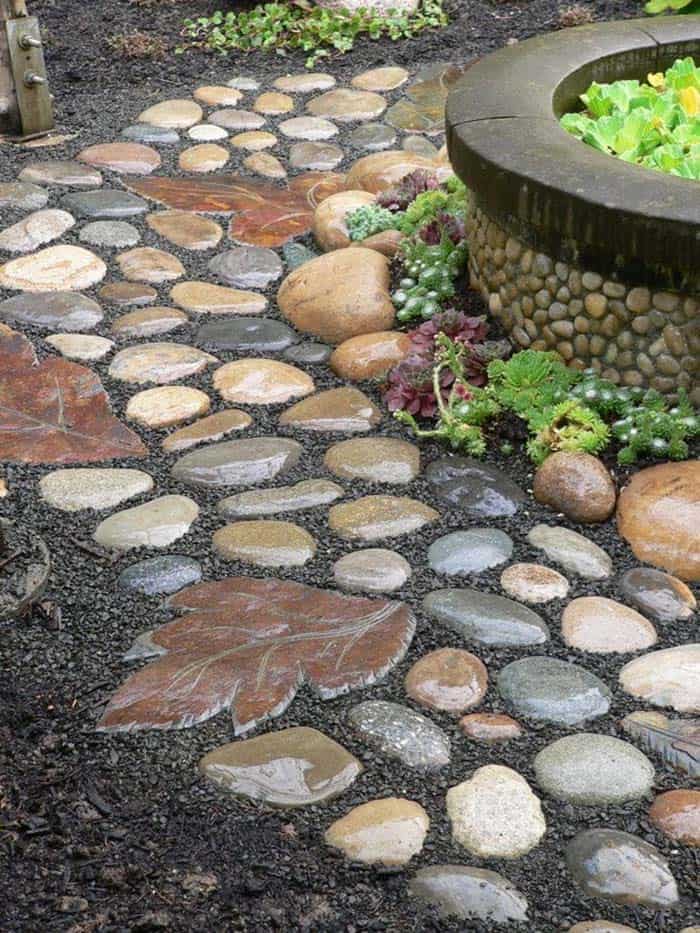
Repurposing old tiles is a great way to create a vibrant, affordable walkway. If you have leftover tiles from a renovation project or can find cheap tiles at a thrift store, this is an ideal solution for an eco-friendly, colorful pathway.
Begin by laying down a gravel or sand base to ensure proper drainage. Next, arrange your tiles in a pattern that appeals to you – you can mix different colors, shapes, and sizes for a fun mosaic look. For a more uniform appearance, you can opt for a matching set of tiles. Once the tiles are arranged, fill the gaps with grout or sand to secure them in place.
Not only does this idea save money by repurposing materials, but it also allows you to create a truly unique walkway with a splash of color and personality.
7. Sand and Gravel Mix: Soft and Stable
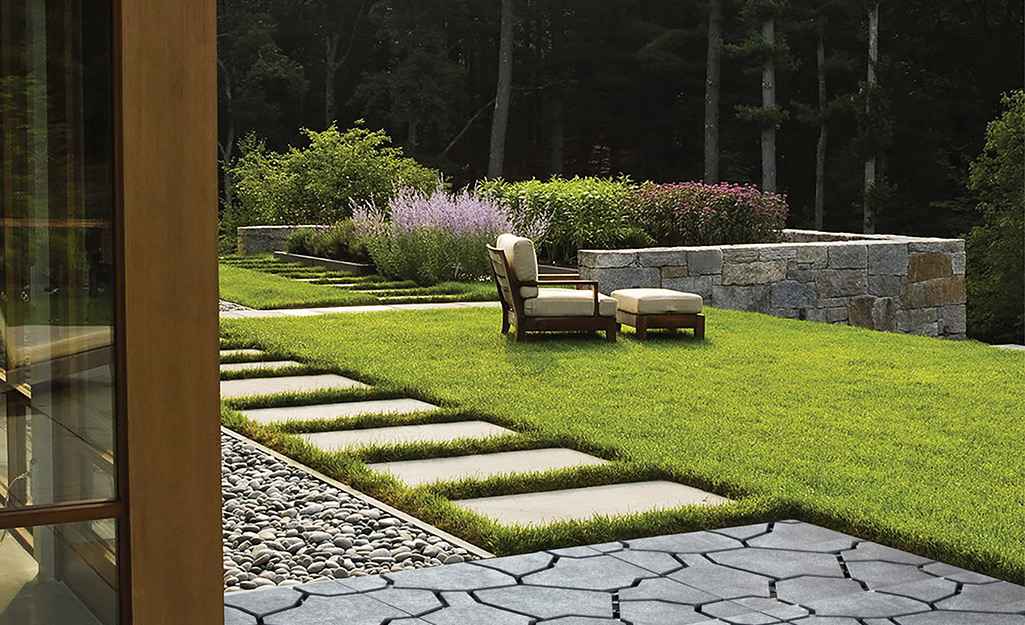
A sand and gravel mix provides the best of both worlds – a soft, textured surface that’s stable enough for walking. This simple, budget-friendly walkway is ideal for creating a more informal, relaxed vibe in your garden or backyard.
To create this path, start by digging a shallow trench where you want your walkway to go. Lay down a weed barrier fabric to keep unwanted plants from growing through. Then, pour a mixture of sand and gravel into the trench, spreading it evenly. For added stability, you can add a layer of larger gravel along the edges to define the path and keep the smaller stones in place.
This type of walkway is perfect for low-traffic areas or for gardens where you want to maintain a natural, easy-going aesthetic.
8. Mulch Walkway: Eco-Friendly and Soft
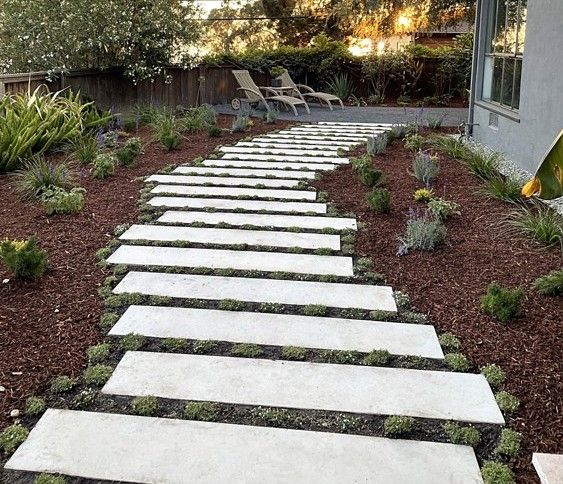
A mulch walkway is one of the most affordable and eco-friendly options available. Not only does it provide a soft surface to walk on, but mulch also helps retain moisture in the soil, making it a great choice for garden paths.
Start by clearing the area where you want to install the walkway and laying down a weed barrier to prevent unwanted growth. Then, add a thick layer of mulch, spreading it evenly over the path. You can use wood chips, bark, or even shredded leaves, depending on your preference. For added definition, you can line the edges of the walkway with bricks or small stones.
A mulch walkway is perfect for garden paths that need to blend in with the natural surroundings and provides an easy, low-maintenance solution for your DIY project.
9. Shell Pathway: Beachy Charm
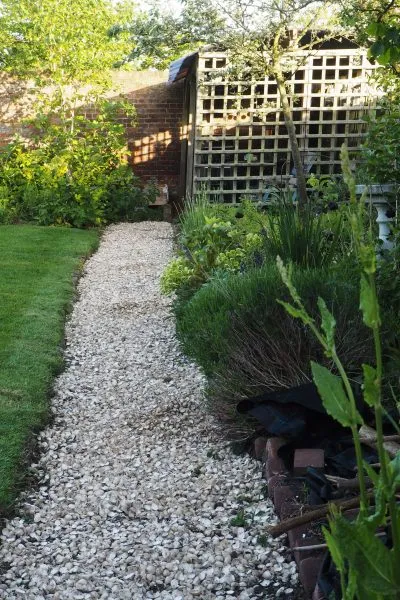
If you love the idea of creating a coastal vibe in your garden, a shell pathway is a great option. Using seashells to create a path not only gives your outdoor space a beachy, textured look, but it’s also a low-cost way to repurpose materials that might otherwise go to waste.
To create a shell walkway, first lay down a base of sand or crushed stone. Next, spread the shells evenly over the path, creating a thick layer. For stability, you can mix the shells with other materials like small stones or gravel. If you want the shells to stay in place, consider creating a border with bricks or large stones along the edges.
The unique texture and color of shells will add a beautiful and coastal touch to any outdoor space.
10. Wood Plank Pathway: Clean and Simple
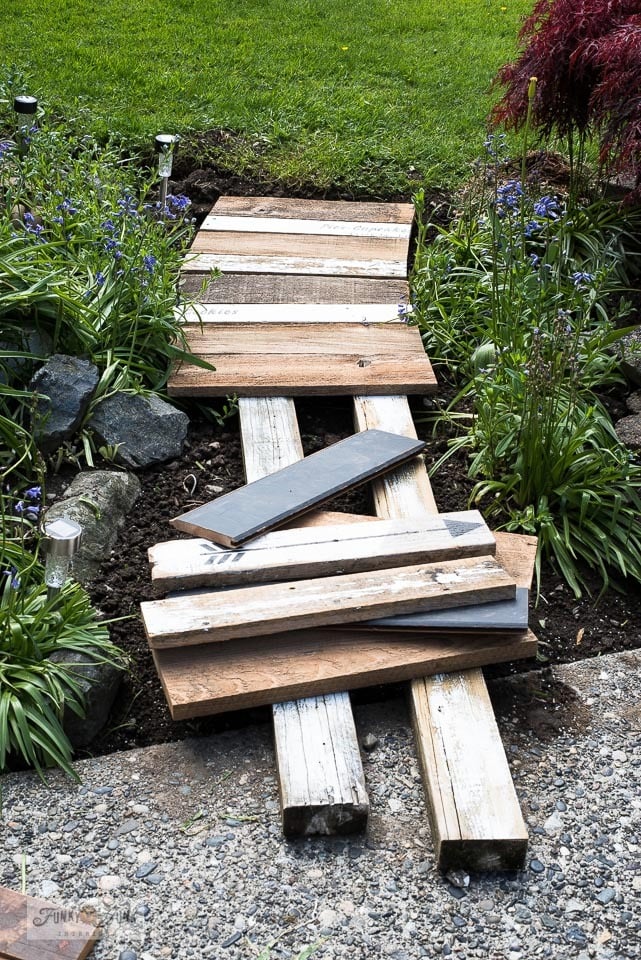
For a clean, minimalist look, a wood plank pathway is an ideal option. Wood planks create a sleek, modern feel without requiring expensive materials or complicated installation. Plus, it’s a great way to repurpose old wood or pallets for an eco-friendly DIY project.
Start by arranging the wood planks in a straight line or in a simple geometric pattern. You can use reclaimed wood from old furniture or buy inexpensive planks at a home improvement store. To install, dig a shallow trench to lay the planks in, ensuring they sit securely in place. You can space them out a bit for added interest or place them closely together for a more solid surface.
This type of pathway works well in both contemporary and rustic settings and is easy to maintain by simply replacing planks as needed.
11. Concrete Slab Walkway: Modern and Minimalist
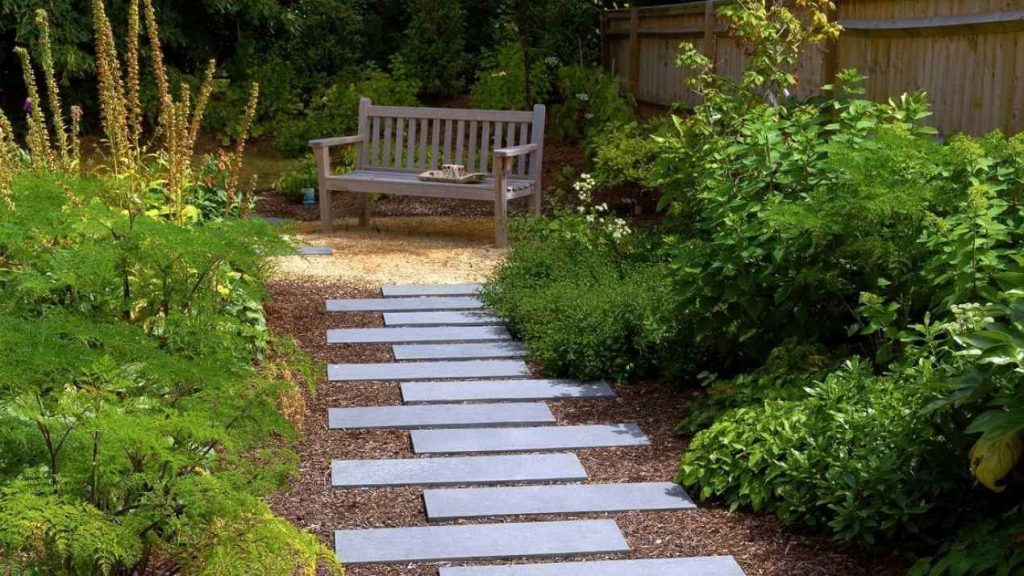
Concrete slabs are a popular choice for those seeking a modern, minimalist look for their outdoor spaces. A concrete slab walkway is not only budget-friendly but also incredibly durable, making it a great investment for your garden or patio.
To create a concrete slab walkway, you’ll need to pour concrete into molds or use pre-made slabs. Lay down a weed barrier and level the ground before placing the slabs in your desired pattern. You can arrange them in a straight line for a clean look or stagger them for a more relaxed feel. To complete the look, fill in the gaps with gravel or grass.
A concrete slab pathway offers a sleek, modern touch to any outdoor area, while its durability ensures it will last for years to come.
12. Upcycled Tire Walkway: Eco-Friendly and Fun
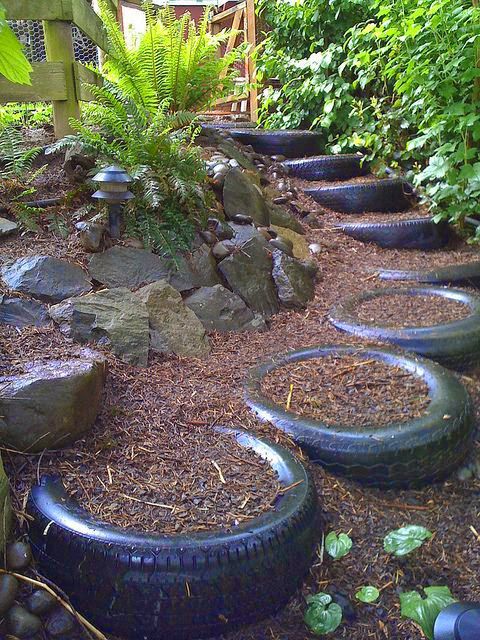
Repurposing old tires is an excellent way to create a fun, eco-friendly walkway. This DIY project is perfect for those who love unique, quirky designs. Old tires are not only durable but also versatile, allowing you to experiment with different layouts and patterns.
To create a tire walkway, begin by cutting the tires in half and arranging them in a path. You can stack them, arrange them side by side, or even cut out sections to create different shapes. For extra flair, you can paint the tires in bright colors or use them as planters along the edges of the path.
This creative walkway option is budget-friendly, eco-conscious, and offers a playful, unique touch to your outdoor space.
13. Succulent Garden Path: A Green, Low-Maintenance Option
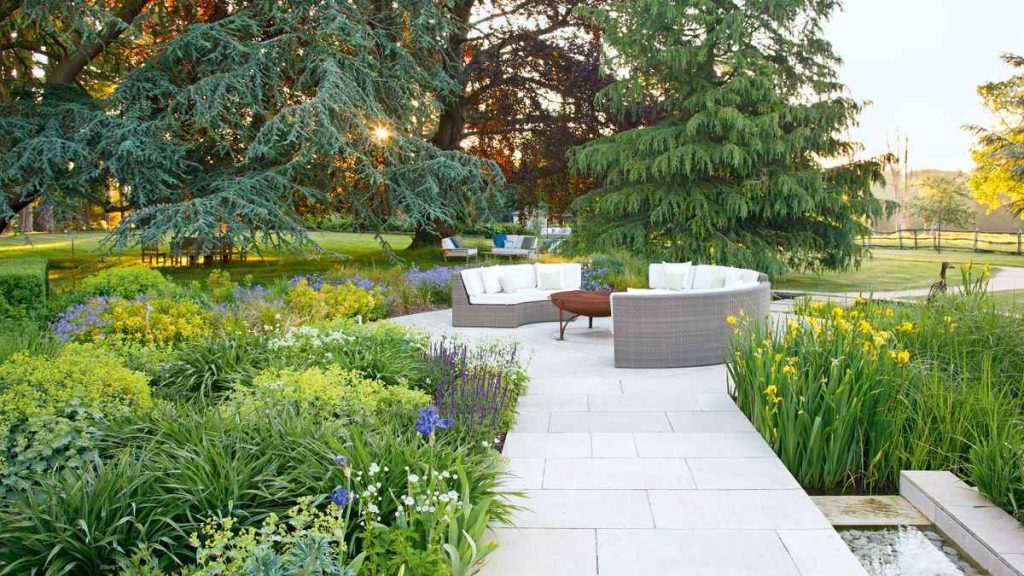
If you love the idea of adding plants to your walkway, a succulent garden path is a perfect choice. Succulents are hardy, low-maintenance, and come in a wide variety of colors and textures, making them ideal for a garden path that’s both beautiful and functional.
To create a succulent garden walkway, start by selecting the right area in your garden that gets plenty of sunlight. Lay down a weed barrier fabric to prevent unwanted plants from growing through. Arrange the succulents between stepping stones or bricks, ensuring there’s enough space for them to grow and spread over time. You can also plant them in small sections to create a mosaic-like effect.
Succulent walkways are not only visually stunning, but they also require minimal upkeep, making them a low-maintenance option for busy homeowners.
14. Pallet Wood Walkway: Rustic and Recycled
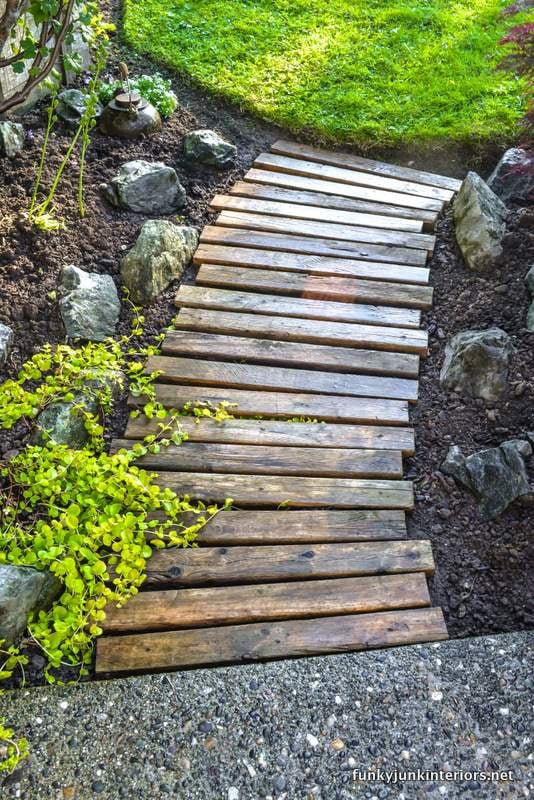
Pallet wood is a fantastic, cost-effective material for creating a rustic walkway. If you have access to old pallets, you can repurpose them to create a unique, eco-friendly path that will add character to your garden.
To build a pallet wood walkway, start by dismantling the pallets and sanding down the wood for a smoother surface. Lay the planks on the ground in a row, leaving space between them to create a path. For a more solid surface, you can place the pallets flat on the ground or secure them with wooden stakes. Depending on your preference, you can leave the wood natural, stain it, or paint it for a personalized touch.
Pallet wood walkways are a fantastic way to recycle materials and add rustic charm to your outdoor space on a budget.
15. Recycled Glass Walkway: Eco-Friendly and Colorful
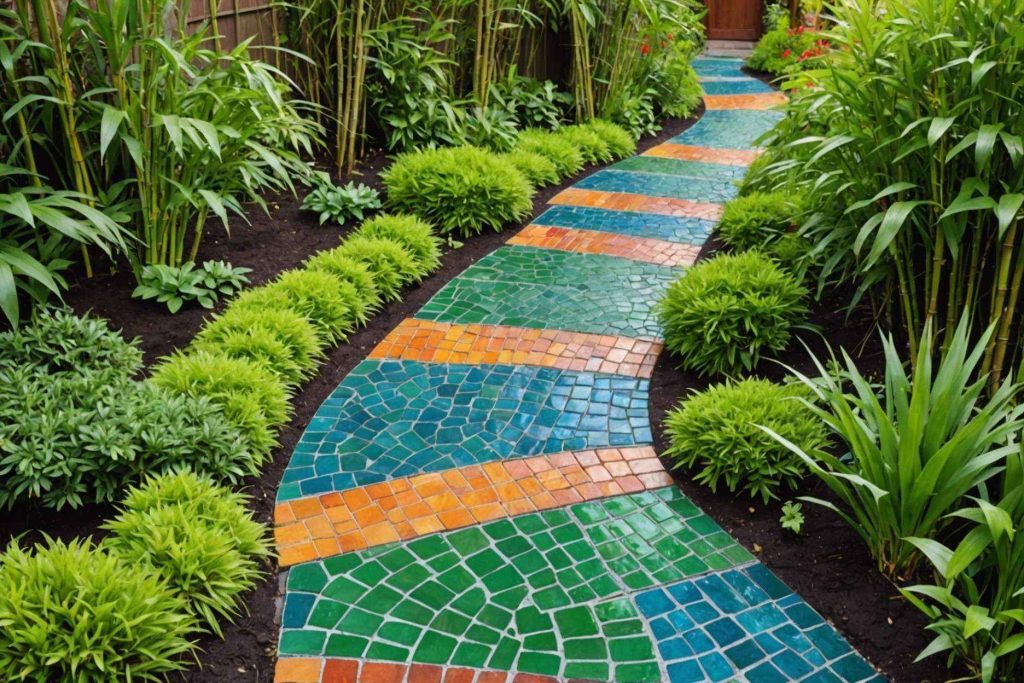
Recycling glass is not only environmentally friendly but also adds a touch of color and texture to your walkway. You can create a beautiful and unique path by using old glass bottles, broken tiles, or even glass marbles.
To build a recycled glass walkway, begin by laying a base of crushed stone or gravel. Then, arrange your glass pieces in a pattern that suits your style – you can mix different colors for a mosaic look or use all one color for a more uniform appearance. For a more solid surface, consider mixing the glass with concrete or grout. Seal the glass with a layer of resin to help prevent sharp edges and keep the glass in place.
This walkway idea is not only a great way to repurpose glass, but it also creates a dazzling, colorful path that will catch the light beautifully.
16. Rock and Pebble Pathway: Natural Elegance
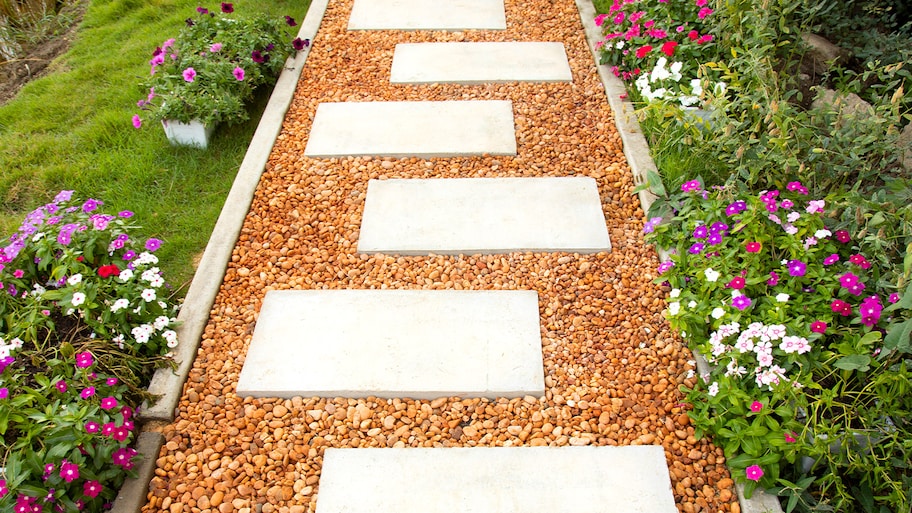
If you love the natural look, a rock and pebble pathway is a perfect option for your garden. Using river rocks or smooth pebbles can create a sleek, sophisticated pathway that blends well with the surrounding greenery.
To create a rock and pebble walkway, begin by digging a shallow trench and laying down a weed barrier. Then, spread a layer of crushed stone as the base before adding the pebbles. You can mix different sizes of rocks to create a more textured look or use uniform-sized pebbles for a cleaner, more polished design. For added definition, consider edging the path with larger rocks or bricks.
This type of pathway offers a durable, low-maintenance option that brings a natural, organic feel to any garden.
17. Painted Concrete Walkway: Colorful and Creative
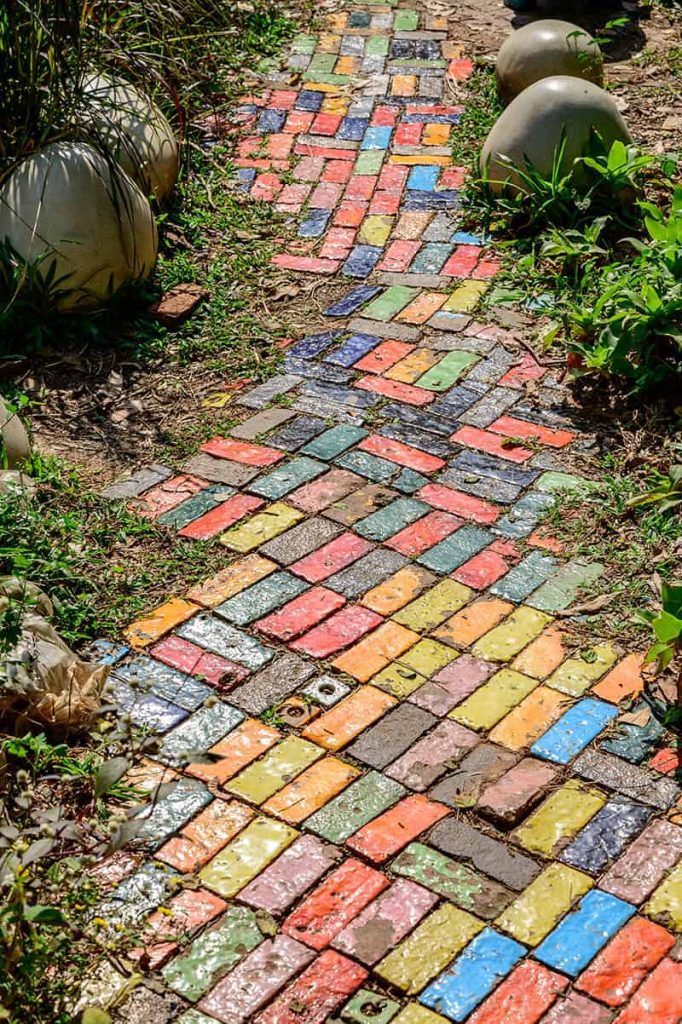
If you have an existing concrete pathway that could use a refresh, painting it is an affordable and creative way to give it a new life. A painted concrete walkway allows you to incorporate fun patterns, vibrant colors, or even a custom design that reflects your personality.
To create a painted concrete walkway, start by cleaning the surface thoroughly and applying a coat of concrete primer. Once dry, you can use stencils or painter’s tape to create a pattern or design of your choice. Whether you opt for stripes, geometric shapes, or a free-form design, the possibilities are endless. Finish off with a concrete sealer to protect your design from the elements.
This is an excellent way to update an old path and add a pop of color to your outdoor living space.
18. Lawn Walkway: Soft and Simple
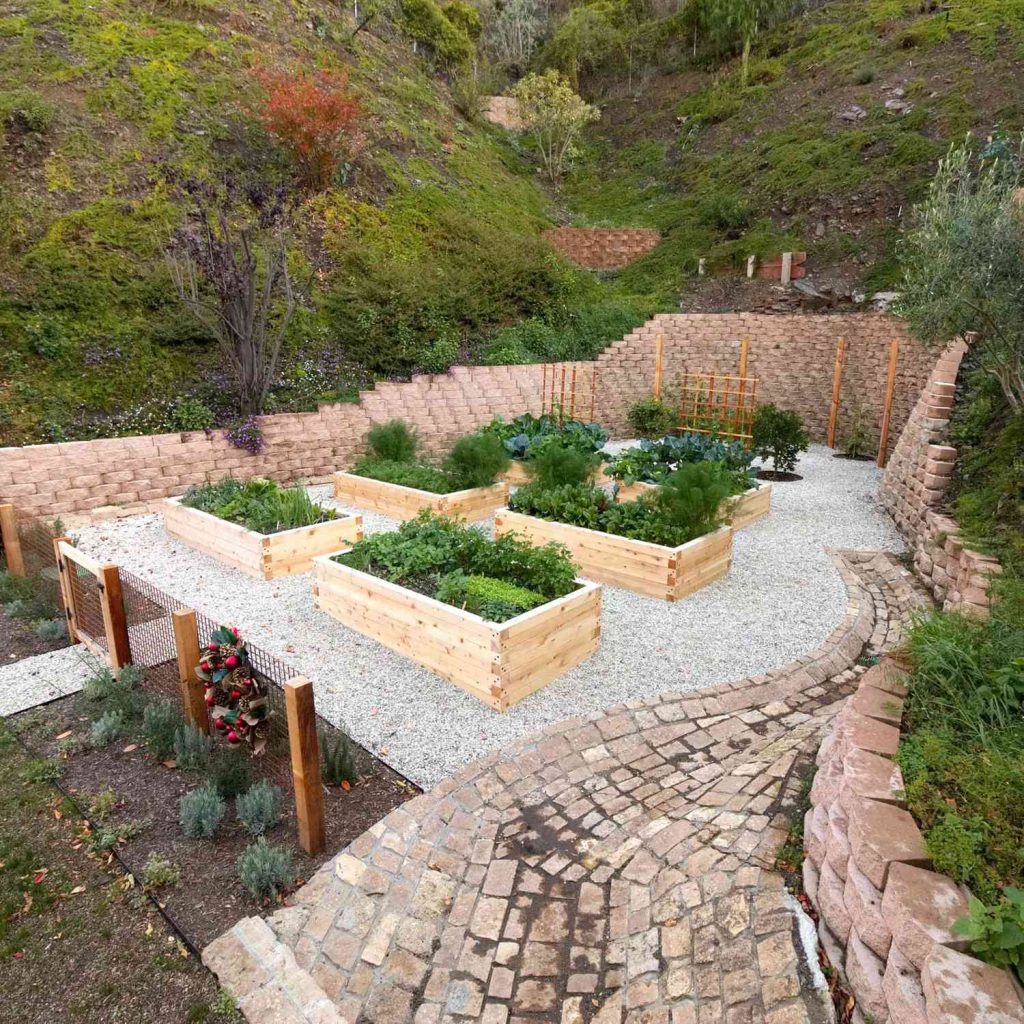
A lawn walkway is one of the simplest and most natural ways to create a path through your garden. It’s perfect for those who want a soft, grassy surface that blends seamlessly into the surroundings.
To create a lawn walkway, begin by marking out the area where you want the path to go. Cut the grass along the edges to define the path and remove any excess soil to create a slight depression. For a more defined edge, you can install a border of bricks, stones, or timber. This type of walkway is low-cost and provides a lush, green look that works well with both traditional and modern landscaping styles.
Lawn walkways are ideal for casual, everyday use and require little maintenance, aside from mowing the grass.
19. Concrete Slab with Moss Between: Rustic Modern
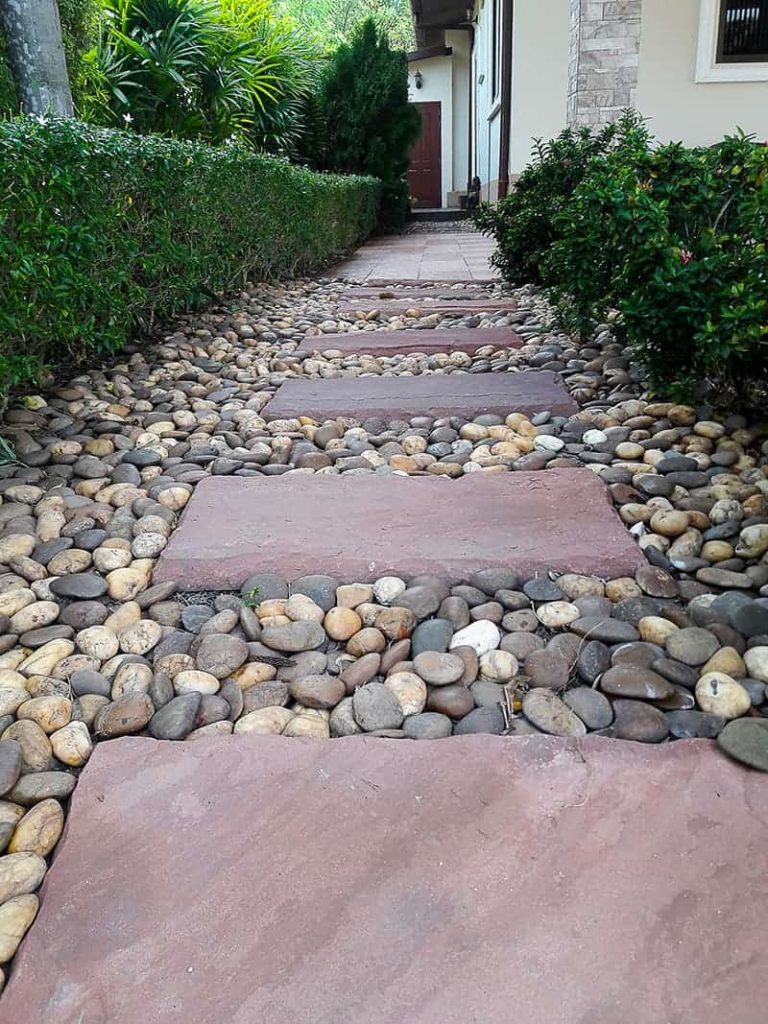
For a rustic yet modern look, combining concrete slabs with moss growing between them is a beautiful way to create a stylish walkway. The contrast between the sleek concrete and the lush, green moss adds texture and visual interest to your outdoor space.
To create this walkway, start by laying concrete slabs in a pattern that suits your style. Once the slabs are in place, plant moss between them and water regularly until it establishes. Moss is easy to grow and requires very little maintenance, making it a great option for a low-maintenance walkway that also looks beautiful.
This walkway idea strikes the perfect balance between modern simplicity and natural beauty.
20. Tile and Gravel Combo: Textural Contrast
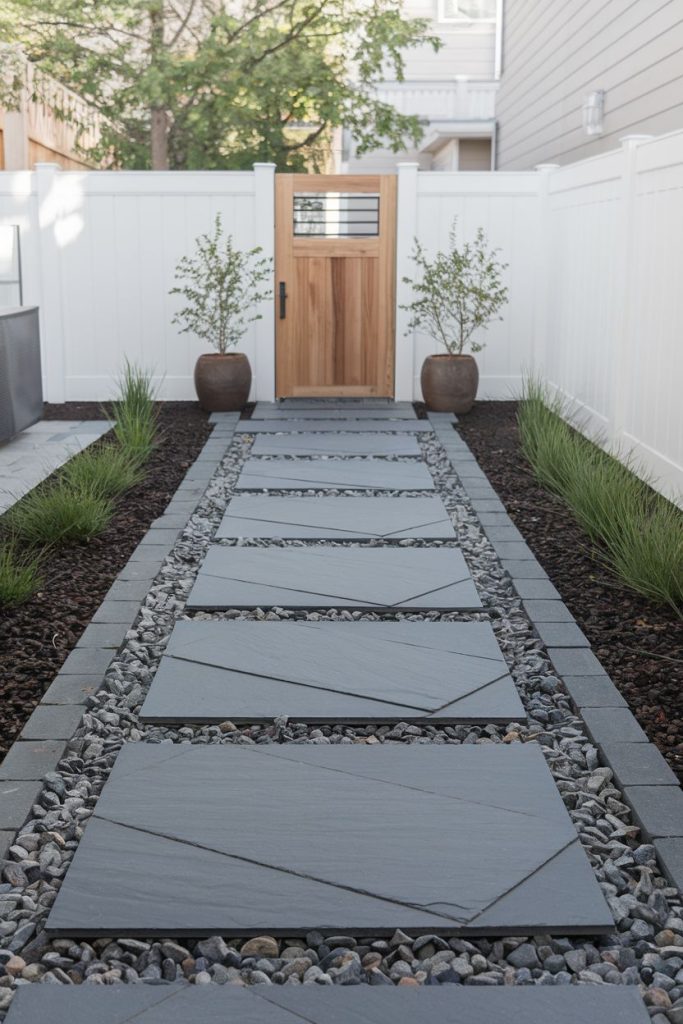
A tile and gravel combo pathway is a unique way to add texture and contrast to your garden. The smooth tiles paired with the rugged, uneven gravel create a beautiful visual contrast that’s both functional and aesthetic.
To create this walkway, begin by laying tiles in a grid pattern, ensuring they’re spaced evenly apart. Fill in the gaps with gravel, sand, or pebbles to create a more dynamic texture. You can use ceramic, terracotta, or even reclaimed tiles to add character and charm to your path.
This DIY walkway is perfect for those looking for a design that combines hard and soft surfaces, providing both durability and visual interest.
21. Reclaimed Wood Walkway: Eco-Friendly and Charming
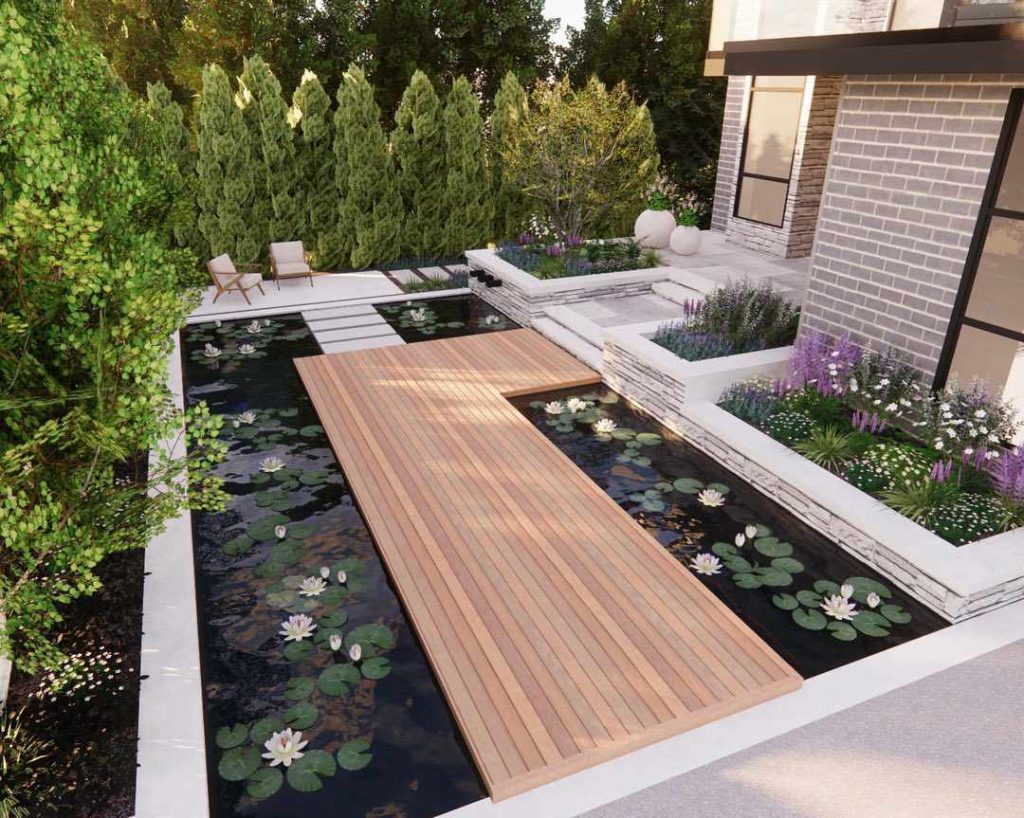
Reclaimed wood is not only a sustainable option, but it also adds a rustic, warm feel to your outdoor space. Whether you’re using old barn wood, pallets, or wood from a renovation project, this is a fantastic way to repurpose materials into a beautiful walkway.
To create a reclaimed wood walkway, start by cutting the wood into uniform planks and laying them out in a pattern of your choice. You can leave the planks loose for a more natural, rustic look or secure them with nails for added stability. For added charm, you can stain or paint the wood to match your outdoor decor.
A reclaimed wood walkway is not only budget-friendly but also adds a unique, personalized touch to your garden.
22. Upcycled Concrete Blocks Pathway: Sturdy and Stylish
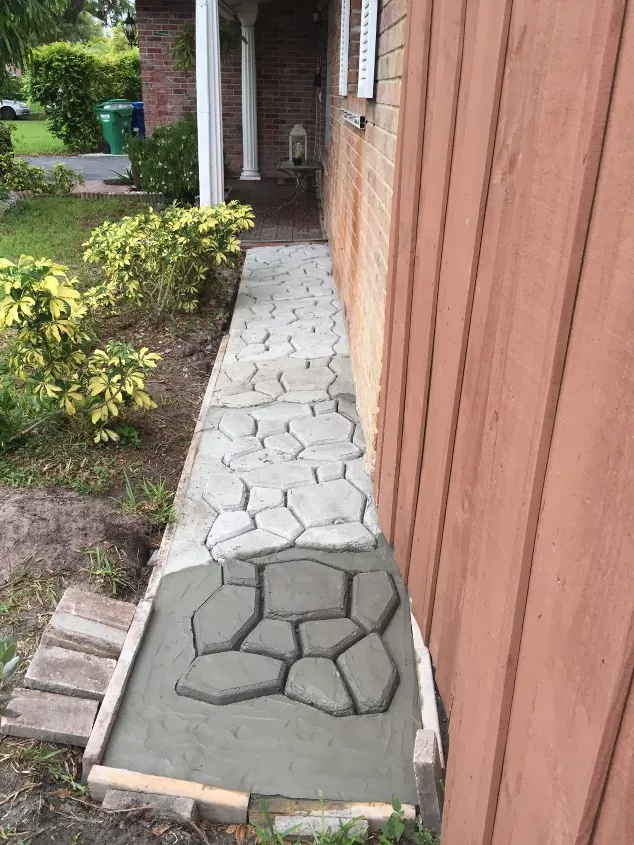
Concrete blocks are often discarded, but with a bit of creativity, they can be turned into a sturdy, stylish walkway for your garden. This option is perfect for those who want a clean, modern look on a budget.
To create a concrete block pathway, start by laying down a weed barrier and leveling the ground. Arrange the blocks in a simple, geometric pattern and fill in the gaps with gravel, sand, or moss. You can choose to keep the concrete blocks in their natural state for a minimalist design or paint them for a more customized look.
This pathway is not only durable but also highly customizable, allowing you to create a walkway that matches your unique style.
23. Stone Steppers with Ground Cover: Nature’s Pathway
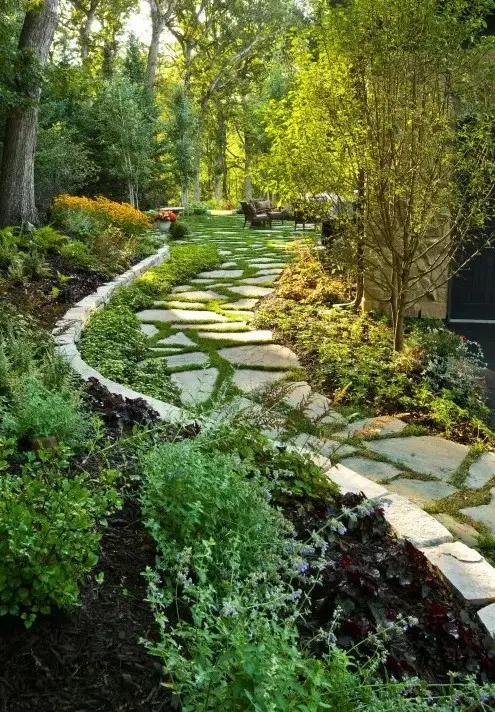
For a truly natural look, use stone steppers with ground cover like creeping thyme or clover to create a green, fragrant pathway. This is an excellent choice for gardeners who love low-maintenance, eco-friendly solutions.
To create this walkway, begin by placing large stone steppers in a zigzag or straight line. Between the stones, plant ground cover plants that will gradually spread and fill in the gaps. Over time, the ground cover will create a lush, green path that feels like walking through nature itself.
This walkway idea is perfect for those who want to combine functionality with sustainability, creating a serene, fragrant path through their garden.
Conclusion:
With these 23 cheap DIY walkway ideas, you have a variety of options to choose from, all designed to help you create a beautiful, functional pathway in your garden or backyard without spending a fortune. Whether you’re repurposing old materials like pallets and tires, or creating something unique with gravel, concrete, or succulents, each of these ideas offers a cost-effective solution that can elevate your outdoor space.
DIY walkways not only enhance the aesthetics of your garden, but they also provide a sense of accomplishment and personalization. Choose the pathway that best fits your style, and enjoy the process of transforming your outdoor living space into a place of beauty and relaxation.
Happy building!





